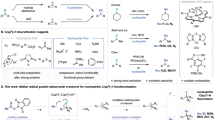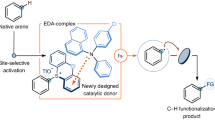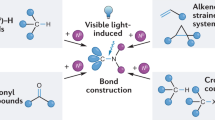Abstract
Photoinduced C(sp3)–H functionalization through hydrogen atom transfer (HAT) processes is pivotal in organic synthesis because of the mild reaction conditions and applicability to late-stage functionalization of complex molecules, such as pharmaceuticals and agrochemicals. Despite promise, achieving precise site-selectivity and overcoming the high bond dissociation energy (BDE) of unactivated aliphatic C–H bonds in photoinduced C(sp3)–H functionalization reactions, through HAT, are challenging. In this landscape, pyridine N-oxides have emerged as potent HAT reagents due to their easily tunable nature. This Perspective highlights studies showcasing the potential of pyridine N-oxides as HAT reagents in site-selective hydrogen atom abstraction from unactivated C(sp3)–H bonds and explores their structure–activity relationship with multiple hydrocarbon substrates. Pyridine N-oxides have become promising reagents in environmentally friendly synthesis owing to their cost-effectiveness, tunability and applicability in (heterogeneous) catalysis. Ongoing research on the use of pyridine N-oxides as HAT reagents will probably offer additional avenues for efficient and selective C(sp3)–H bond functionalization.

This is a preview of subscription content, access via your institution
Access options
Subscribe to this journal
Receive 12 digital issues and online access to articles
$119.00 per year
only $9.92 per issue
Buy this article
- Purchase on Springer Link
- Instant access to full article PDF
Prices may be subject to local taxes which are calculated during checkout





Similar content being viewed by others
References
Hanukoglu, I. Steroidogenic enzymes: structure, function and role in regulation of steroid hormone biosynthesis. J. Steroid Biochem. Mol. Biol. 43, 779–804 (1992).
Kaspera, R. & Croteau, R. Cytochrome P450 oxygenases of taxol biosynthesis. Phytochem. Rev. 5, 433–444 (2006).
Lewis, J. C., Coelho, P. S. & Arnold, F. H. Enzymatic functionalization of carbon-hydrogen bonds. Chem. Soc. Rev. 40, 2003–2021 (2011).
Darcy, J. W., Koronkiewicz, B., Parada, G. A. & Mayer, J. M. A continuum of proton-coupled electron transfer reactivity. Acc. Chem. Res. 51, 2391–2399 (2018).
Yi, H. et al. Recent advances in radical C-H activation/radical cross-coupling. Chem. Rev. 117, 9016–9085 (2017).
Wang, X. & Studer, A. Iodine(III) reagents in radical chemistry. Acc. Chem. Res. 50, 1712–1724 (2017).
Kärkäs, M. D. Electrochemical strategies for C-H functionalization and C-N bond formation. Chem. Soc. Rev. 47, 5786–5865 (2018).
Capaldo, L. & Ravelli, D. Hydrogen atom transfer (HAT): a versatile strategy for substrate activation in photocatalyzed organic synthesis. Eur. J. Org. Chem. 2017, 2056–2071 (2017).
Cao, H., Tang, X., Tang, H., Yuan, Y. & Wu, J. Photoinduced intermolecular hydrogen atom transfer reactions in organic synthesis. Chem. Catal. 1, 523–598 (2021).
Capaldo, L., Ravelli, D. & Fagnoni, M. Direct photocatalyzed hydrogen atom transfer (HAT) for aliphatic C-H bonds elaboration. Chem. Rev. 122, 1875–1924 (2022).
Chang, L. et al. Resurgence and advancement of photochemical hydrogen atom transfer processes in selective alkane functionalizations. Chem. Sci. 14, 6841–6859 (2023).
Shaw, M. H., Twilton, J. & MacMillan, D. W. C. Photoredox catalysis in organic chemistry. J. Org. Chem. 81, 6898–6926 (2016).
Galli, C., Gentili, P. & Lanzalunga, O. Hydrogen abstraction and electron transfer with aminoxyl radicals: synthetic and mechanistic issues. Angew. Chem. Int. Ed. 47, 4790–4796 (2008).
Wu, Z.-X., Hu, G.-W. & Luan, Y.-X. Development of N-hydroxy catalysts for C-H functionalization via hydrogen atom transfer: challenges and opportunities. ACS Catal. 12, 11716–11733 (2022).
Yang, C., Arora, S., Maldonado, S., Pratt, D. A. & Stephenson, C. R. J. The design of PINO-like hydrogen-atom-transfer catalysts. Nat. Rev. Chem. 7, 653–666 (2023).
Leifert, D. & Studer, A. Organic synthesis using nitroxides. Chem. Rev. 123, 10302–10380 (2023).
Youssif, S. Recent trends in the chemistry of pyridine N-oxides. Arkivoc 1, 242–268 (2001).
Li, D. et al. The diversity of heterocyclic N-oxide molecules: highlights on their potential in organic synthesis, catalysis and drug applications. Curr. Org. Chem. 23, 616–627 (2019).
Habib, I., Singha, K. & Hossain, M. Recent progress on pyridine N-oxide in organic transformations: a review. ChemistrySelect 8, e202204099 (2023).
Wang, D., Désaubry, L., Li, G., Huang, M. & Zheng, S. Recent advances in the synthesis of C2-functionalized pyridines and quinolines using N-oxide chemistry. Adv. Synth. Catal. 363, 2–39 (2021).
Wang, Y. & Zhang, L. Recent developments in the chemistry of heteroaromatic N-oxides. Synthesis 47, 289–305 (2015).
Xu, J., Wu, W. & Wu, J. Photoinduced divergent alkylation/acylation of pyridine N-oxides with alkynes under anaerobic and aerobic conditions. Org. Lett. 21, 5321–5325 (2019).
Kim, I. et al. Site-selective functionalization of pyridinium derivatives via visible-light-driven photocatalysis with quinolinone. J. Am. Chem. Soc. 141, 9239–9248 (2019).
Markham, J. P., Wang, B., Stevens, E. D., Burris, S. C. & Deng, Y. ortho-Alkylation of pyridine N-oxides with alkynes by photocatalysis: pyridine N-oxide as a redox auxiliary. Chem. Eur. J. 25, 6638–6644 (2019).
Li, D. et al. Visible-light-promoted C2 selective arylation of quinoline and pyridine N-oxides with diaryliodonium tetrafluoroborate. J. Org. Chem. 85, 2733–2742 (2020).
Mathi, G. R. et al. H functionalization of heteroarene N-oxides enabled by a traceless nucleophile. Angew. Chem. Int. Ed. 59, 22675–22683 (2020).
Beatty, J. W., Douglas, J. J., Cole, K. P. & Stephenson, C. R. J. A scalable and operationally simple radical trifluoromethylation. Nat. Commun. 6, 7919 (2015).
Kim, I., Min, M., Kang, D., Kim, K. & Hong, S. Direct phosphonation of quinolinones and coumarins driven by the photochemical activity of substrates and products. Org. Lett. 19, 1394–1397 (2017).
Capaldo, L. & Ravelli, D. Alkoxy radicals generation: facile photocatalytic reduction of N-alkoxyazinium or azolium salts. Chem. Commun. 55, 3029–3032 (2019).
He, F.-S., Ye, S. & Wu, J. Recent advances in pyridinium salts as radical reservoirs in organic synthesis. ACS Catal. 9, 8943–8960 (2019).
McClain, J. E., Wortman, A. K. & Stephenson, C. R. J. Radical generation enabled by photoinduced N-O bond fragmentation. Chem. Sci. 13, 12158–12163 (2022).
Schlegel, M., Qian, S. & Nicewicz, D. A. Aliphatic C–H functionalization using pyridine N-oxides as H-atom abstraction agents. ACS Catal. 12, 10499–10505 (2022).
Wang, B. et al. Photoinduced site-selective functionalization of aliphatic C-H bonds by pyridine N-oxide based HAT catalysts. ACS Catal. 12, 10441–10448 (2022).
Ciszewski, Ł. W. & Gryko, D. Pyridine N-oxides as HAT reagents for photochemical C-H functionalization of electron-deficient heteroarenes. Chem. Commun. 58, 10576–10579 (2022).
Mech, P., Bogunia, M., Nowacki, A. & Makowski, M. Calculations of pKa values of selected pyridinium and its N-oxide ions in water and acetonitrile. J. Phys. Chem. A 124, 538–551 (2020).
Teufel, R. et al. Flavin-mediated dual oxidation controls an enzymatic Favorskii-type rearrangement. Nature 503, 552–556 (2013).
Miyazaki, H., Kubota, T. & Yamakawa, M. The characterization of the electronic spectra of heterocyclic amine N-oxides by means of the non-aqueous oxidation and reduction potentials and the substituent effects on them. Bull. Chem. Soc. Jpn 45, 780–785 (1972).
Koldasheva, E. M., Geletii, Y. V., Yanilkin, V. V. & Strelets, V. V. Electrogenerated cation radicals of heteroaromatic N-oxides and oxidation of cyclohexane induced by them. Bull. Acad. Sci. USSR Div. Chem. Sci. 39, 886–890 (1990).
Sako, M., Shimada, K., Hirota, K. & Maki, Y. Photochemical oxygen-atom transfer reaction by heterocycle N-oxides involving a single-electron transfer process: oxidative demethylation of N,N-dimethylaniline. J. Am. Chem. Soc. 108, 6039–6041 (1986).
Nakanishi, I. et al. Hydroxyl radical generation via photoreduction of a simple pyridine N-oxide by an NADH analogue. Org. Biomol. Chem. 3, 3263–3265 (2005).
Li, H., Xie, F. & Zhang, M.-T. Metal-free electrocatalyst for water oxidation initiated by hydrogen atom transfer. ACS Catal. 11, 68–73 (2021).
Laze, L., Quevedo-Flores, B., Bosque, I. & Gonzalez-Gomez, J. C. Alkanes in minisci-type reaction under photocatalytic conditions with hydrogen evolution. Org. Lett. 25, 8541–8546 (2023).
Bietti, M. Activation and deactivation strategies promoted by medium effects for selective aliphatic C-H bond functionalization. Angew. Chem. Int. Ed. 57, 16618–16637 (2018).
Yamada, K. et al. Photocatalyzed site-selective C-H to C-C conversion of aliphatic nitriles. Org. Lett. 17, 1292–1295 (2015).
Fukuyama, T. et al. Site-selectivity in TBADT-photocatalyzed C(sp3)-H functionalization of saturated alcohols and alkanes. Chem. Lett. 47, 207–209 (2018).
Zhi, Y., Wang, Z., Zhang, H.-L. & Zhang, Q. Recent progress in metal-free covalent organic frameworks as heterogeneous catalysts. Small 16, 2001070 (2020).
Mak, C. H. et al. Heterogenization of homogeneous photocatalysts utilizing synthetic and natural support materials. J. Mater. Chem. A 9, 4454–4504 (2021).
López-Magano, A. et al. Recent advances in the use of covalent organic frameworks as heterogenous photocatalysts in organic synthesis. Adv. Mater. 35, 2209475 (2023).
Pang, H. et al. Embedding hydrogen atom transfer moieties in covalent organic frameworks for efficient photocatalytic C-H functionalization. Angew. Chem. Int. Ed. 62, e202313520 (2023).
Li, X. et al. Chemically robust covalent organic frameworks: progress and perspective. Matter 3, 1507–1540 (2020).
Acknowledgements
J.W. acknowledges financial support provided by the National Research Foundation, the Prime Minister’s Office of Singapore, under its NRF-CRP Programme (award no. NRFCRP25-2020RS-0002), Pfizer (A-8000004-00-00) and the NUS (Chongqing) Research Institute, National Natural Science Foundation of China (grant nos. 22071170 and 22371200). D.R. acknowledges support from the Ministero dell’Università e della Ricerca (MUR) and the University of Pavia through the program ‘Dipartimenti di Eccellenza 2023–2027’.
Author information
Authors and Affiliations
Contributions
H.T.A., Y.M., D.R. and J.W. contributed to discussions and wrote the manuscript.
Corresponding authors
Ethics declarations
Competing interests
The authors declare no competing interests.
Peer review
Peer review information
Nature Synthesis thanks the anonymous reviewers for their contribution to the peer review of this work. Primary Handling Editor: Thomas West, in collaboration with the Nature Synthesis team.
Additional information
Publisher’s note Springer Nature remains neutral with regard to jurisdictional claims in published maps and institutional affiliations.
Rights and permissions
Springer Nature or its licensor (e.g. a society or other partner) holds exclusive rights to this article under a publishing agreement with the author(s) or other rightsholder(s); author self-archiving of the accepted manuscript version of this article is solely governed by the terms of such publishing agreement and applicable law.
About this article
Cite this article
Ang, H.T., Miao, Y., Ravelli, D. et al. Pyridine N-oxides as hydrogen atom transfer reagents for site-selective photoinduced C(sp3)–H functionalization. Nat. Synth 3, 568–575 (2024). https://doi.org/10.1038/s44160-024-00528-2
Received:
Accepted:
Published:
Issue Date:
DOI: https://doi.org/10.1038/s44160-024-00528-2



